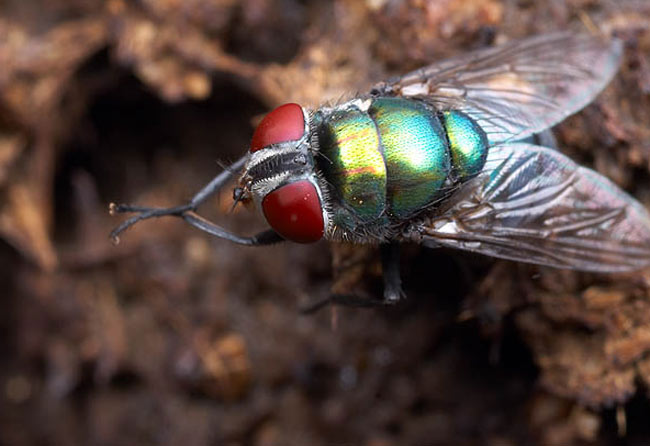How Fat Flies Finesse Flight

Blowflies aren't blessed with sleek bodies and large wings—features that enhance aerodynamics—so they need extra gear for staying aloft.
Turns out the lumbering insects keep from spiraling into dizzying tailspins with help from a special motion-sensitive neuron that picks up information from the insects' eyes, scientists have learned.
"This more than makes up for their lack of passive stability, and in fact makes them extremely maneuverable," said research team member Matthew Parsons of the University of Cambridge.
Like dragonflies and most other flying insects, a blowfly has two compound eyes, each containing thousands of mini-eyes, which cover a large portion of its head, and three simple eyes called ocelli positioned on top of the head.
But until now, scientists have remained in the dark as to how the blowfly's nervous system combined information from the separate sensors in order to elicit the correct motor response.
To isolate how a fly's visual system detects rotation, the researchers removed the legs, wings and mouth parts of each blowfly and waxed the wounds shut. Then they beamed a pattern of flickering light on the fly's ocelli, similar to what it would see if it was rotating in the air.
They found that a particular neuron called V1, which responds to rotation signals from compound eyes, also responded to the light flashes on the ocelli.
Sign up for the Live Science daily newsletter now
Get the world’s most fascinating discoveries delivered straight to your inbox.
Both eye types have their advantages.
With so many facets, compound eyes can resolve fine details of an image, but relaying and processing the information can take time. Ocelli contain a single lens, and generate blurry images, as if looking at the world through a piece of tissue paper, Parsons explained. But ocelli are much quicker at jetting signals to the fly's brain—a characteristic important when a fly is poised to possibly crash.
Combining the two types of eyes for a single purpose like motion detection can cancel out the disadvantages, the researchers reported in the Nov. 15 issue of the Journal of Experimental Biology.
- How Bees See
- Backyard Bugs: The Best of Your Images
- Top 10 Secret Bug Weapons
- How the Human Eye Works
- Flight of the Fly
Jeanna Bryner is managing editor of Scientific American. Previously she was editor in chief of Live Science and, prior to that, an editor at Scholastic's Science World magazine. Bryner has an English degree from Salisbury University, a master's degree in biogeochemistry and environmental sciences from the University of Maryland and a graduate science journalism degree from New York University. She has worked as a biologist in Florida, where she monitored wetlands and did field surveys for endangered species, including the gorgeous Florida Scrub Jay. She also received an ocean sciences journalism fellowship from the Woods Hole Oceanographic Institution. She is a firm believer that science is for everyone and that just about everything can be viewed through the lens of science.









